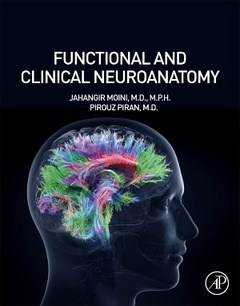Functional and Clinical Neuroanatomy A Guide for Health Care Professionals
Auteurs : Moini Jahangir, Piran Pirouz

Functional and Clinical Neuroanatomy: A Guide for Health Care Professionals is a comprehensive, yet easy-to read, introduction to neuroanatomy that covers the structures and functions of the central, peripheral and autonomic nervous systems. The book also focuses on the clinical presentation of disease processes involving specific structures. It is the first review of clinical neuroanatomy that is written specifically for nurses, physician assistants, nurse practitioners, medical students and medical assistants who work in the field of neurology. It will also be an invaluable resource for graduate and postgraduate students in neuroscience.
With 22 chapters, including two that provide complete neurological examinations and diagnostic evaluations, this book is an ideal resource for health care professionals across a wide variety of disciplines.
1. Histophysiology 2. Embryology 3. Gross Anatomy of the Brain 4. Meninges and Ventricles 5. Blood Supply of the CNS 6. Cerebral Cortex 7. Basal Nuclei 8. Diencephalon: Thalamus and Hypothalamus 9. Brainstem 10. Cranial Nerves 11. Trigeminal and Facial Nerves 12. Auditory System 13. Auditory System Lesions and Disorders 14. Visual System 15. Limbic, Olfactory, and Gustatory Systems 16. Cerebellum 17. Autonomic Nervous System 18. Neurotransmitters 19. Spinal Cord 20. Spinal Cord Lesions and Disorders 21. Complete Neurological Exam 22. Neurologic Diagnostic Procedures
Neuroscientists, neuroanatomists, neurophysiologists, and those working in behavioral neuroscience or neuropharmacology
Dr. Piran is Chief Executive Officer at Wisemen Neurosciences. He completed his fellowship in clinical and research neuro-critical care at the Johns Hopkins University Hospital, and his vascular neurology fellowship training at the Weill Cornell Medical Center in New York City. His neurology residency training was at the Cleveland Clinic in Florida where he served as the Chief resident during his final year. Dr. Piran received his medical degree from Behshti University of Medical Sciences in Tehran, Iran.
- Written specifically for "mid-level" providers in the field of neurology
- Provides an up-to-date review of clinical neuroanatomy based on the latest guidelines
- Provides a logical, step-by-step introduction to neuroanatomy
- Offers hundreds of full-color figures to illustrate important concepts
- Highlights key subjects in "Focus On" boxes
- Includes Section Reviews at critical points in the text of each chapter
Date de parution : 02-2020
Ouvrage de 770 p.
19x23.3 cm
Thèmes de Functional and Clinical Neuroanatomy :
Mots-clés :
Acetylcholine; Acoustic neuroma; Amino acids; Ampulla; Anencephaly; Anosmia; ANS; Anterior cranial fossa; Anterior horns; Arachnoid mater; Auricle; Autonomic nervous system; Basal nuclei; Basilar membrane; Bell’s palsy; Blindness; Brain abscess; Brainstem; Carbohydrates; Carotid arteries; Celiac ganglia; Central nervous system; Cerebellar nuclei; Cerebellomedullary cistern; Cerebellum; Cerebral cortex; Cerebral hemispheres; Cerebrospinal fluid; Cerebrum; Circle of Willis; Clusters; CN X; Computed tomography; Continuous basis; Convergence; Cranial nerves; Craniosacral; Decussation; Diencephalon; Dizziness; Dura mater; Dural sinuses; Dystonias; Electroencephalogram; Electroencephalography; Electromyography; Electronystagmography; Emotional lability; Encephalitis; Encephalocele; Epidural space; Esotropia; Eyeball; Fourth ventricle; Funiculi; Gasserian ganglion; Golgi cells; Gross anatomy; Gustatory system; Hemiballismus; Hemifacial spasm; Herpes zoster; Hippocampal formation; Holoprosencephaly; Homeostasis; Huntington’s chorea; Hydrocephalus; Hypothalamus; Immunoglobulin M; Interneurons; Jaw jerk reflex; Limbic system; Lobule; Lyme disease; Magnetic resonance imaging; Magnetic resonance spectroscopy; Medulla; Melatonin; Mental status; Mesencephalic nucleus; Multiple sclerosis; Muscle strength; Neocortex; Neurologic examination; Neurologic method; Neuromodulators; Neurotransmitters; Nystagmus; Olfactory nerve; Olfactory receptors; Olfactory system; Olives; Parkinson’s disease; Parkinsonism; Peripheral nerves; Peripheral nervous system; Pillar cells; Pinealocytes; Posterior horns; Principal sensory nucleus; Purines; Purkinje cells; Pyramid; Pyramids; Saccule; Schizophrenia; Somatic nervous system; Split-brain syndrome; Strabismus; Substantia nigra; Superficial veins; Sympathetic division; Thalamus; Tinnitus; Transverse sinus; Tuberculosis; Utricle; Vertigo; Visual acuity; Visual cortex; Visual pigments



